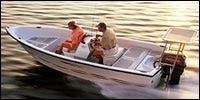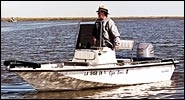
| The bay boat is an extremely versatile design, capable of running the flats and handling open coastal waters. Many of them look a lot like flats skiffs, but usually sport a higher freeboard and a slightly deeper vee to handle choppy seas. (Pathfinder 2200V) |
Inshore fishing has grown rapidly in the last few years, and so has the sale of inshore boats. Flats boats, jonboats and small center consoles in a dizzying variety of styles and shapes are all seen plying our coastal waters on most weekends. The bay boat, or bay skiff, is one of the styles of inshore craft that has benefitted most from this trend.
That’s partly because bay boats are incredibly versatile. You can use them to fish the flats, oyster bars, creeks and bays that define the inshore arena, but they also allow you to travel through more open coastal waters. Another benefit of the design is manageability. Bay boats are usually of a simple, lightweight design (as opposed to an offshore-type center console), so you can push them economically with a smaller outboard. That same attribute also makes them easy to trailer. And many bay boats come with a friendly price tag, too.
What’s a Bay Boat?

Hydra-Sports 22 LTS Tunnel|
Defining a bay boat isn’t all that easy. After all, how does one separate a flats skiff from a bay skiff? Given this predicament, let’s see if we can agree on a few features that bay boats might have in common.
When most people envision a bay boat, they think of a rolled-edge skiff. These skiffs have no inner liner; you get a hull that may have some storage boxes glassed in, with the gunwale tops rolled outward. The inside of the hull is normally painted, with non-skid material added.
Other bay boats go for the full-blown hull/deck/cap approach, complete with gelcoated storage boxes and upscale trim. In reality, bay boats are like every other style of boat on the market: there’s a model to suit every need, taste and budget, from the simple and cheap to the complex and more expensive. It all comes down to what you want, and what you can afford.
On average, bay boats are slightly longer (18 to 23 feet) than most flats skiffs. That’s because they are designed for occasional use in open water, where a chop might spring up. Now, before you pound out a letter to Editor Barry Gibson explaining how you run across miles and miles of open water in your flats skiff every weekend, remember that we’re talking in broad generalizations here. Bear with me for a minute.
Bay boats have a higher freeboard than flats skiffs for the same reason. Flats boats need low freeboard so the wind won’t catch them as easily, which can be a very important consideration when poling. Most people don’t pole bay boats, but come to think of it, a lot flats-skiff owners never pole their boats either.
The hull on a typical bay boat has a slightly deeper vee to cut down chop, so it draws a little more water. But that’s okay, because we know bay boats aren’t meant for use in super-skinny water.
Sensible Layout

Logic 17 Flats|
Another common aspect of these boats concerns layout. Whereas the typical flats skiff features at least one raised casting deck that’s flush with the top of the hullsides, a bay boat has a lower casting deck, if it has one at all, and often a handrail around the cockpit. The angler stands on or near the hull in most bay boats, and if there’s a casting deck, the hullside often features a large lip for a toehold. This all goes back to the concept that bay boats will most likely be used in rougher conditions than a flats skiff.
If you think about it, a flats skiff is seldom operated in rough water, so the guy standing on the casting deck doesn’t have to worry about getting pitched off. Therefore, a level deck is fine. However, if you’re casting for stripers in the mouth of Chesapeake Bay on a windy day, you’ll probably appreciate a toehold, or better yet, a gunwale to brace yourself against.
Many modern bay-boat builders are incorporating huge live well systems into their boats, and it’s not uncommon to find two or three wells on many models. Live-bait fishing has proliferated considerably, and the bay-boat folks have met the demand with innovative well solutions. Need to keep 2,000 pilchards alive all day? No problem!
Some builders are also utilizing design ideas first developed in the flats-skiff market. These include lockable rod lockers, fly-rod tubes, lockable dry storage compartments, and so forth. Of course, you don’t have to be a genius to figure out that a lot of boat companies build both flats skiffs and bay boats, so the transfer of technology is a natural.
Designed to Fish

Triton Bay Flight 22 Tunnel|
Now that you have a rough idea of what a bay boat is, let’s get back to what it does so well: fish. Bay boats have proven incredibly popular with people who love fishing in shallow water, but who aren’t necessarily interested in sight-casting to tailing bonefish all the time. Bay boats are adept at all but the shallowest of inshore tasks, and can be called upon for almost anything else.
Say you enjoy drifting and casting in a shallow bay near your home. A bay boat gives you the ability to pick up and run long distances if you hear of better action at another spot, because they ride well and usually have generous fuel capacities. And you can venture into a larger body of water with less fear of being caught in a sudden storm. The higher freeboard gives you more security.
Good Value

Blue Wave 165 Classic|
If you’re considering buying an inshore boat, here are a few things to consider. First, bay boats tend to be a very good value. As mentioned, they range from the basic rolled-edge skiff with a speckle paint job on the interior to finely finished boats that rival the very best flats skiffs, and everything in between.
Because they’re such a good value, bay boats are purchased by many people as a complement to their larger offshore vessels, or as a first boat for their son or daughter. But if you’re on a tight budget, bay boats can make an excellent primary boat, as well. It’s hard to name a type of boat that’s more versatile.
But an increasing number of serious fishermen are buying these boats and turning them into full-blown, extreme inshore fishing machines with no expense spared. Custom live wells, high-tech electronics, powerful trolling motors, and new fuel-efficient outboard motors are being combined to create a boat that is perfect for covering many miles of mangrove shoreline, sawgrass-lined creeks, rocky coves or beaches.
It’s fair to say that the bay boat has caught up with its more glamorous cousin, the flats skiff, and is now available in models sporting many different levels of fit and finish. However, they all share a simple layout combined with a hull design that lets them work well even when conditions deteriorate somewhat. They can do a lot of different tasks well.
If this sounds good to you, seek out a bay-boat dealer and check one out for yourself. Or better yet, find someone who’s knowledgeable about inshore fishing and ask him about bay boats. Chances are he’s a fan already. And while he may have difficulty precisely describing to you just what a bay boat is, I guarantee you he’ll know one when he sees one. So will you!
| # Bay Boat Sources | |||
| Angler(305) 691-9975www.anglerboats.comAquasport(800) 704-3474www.aquasport.comBay Stealth Boats(800) 256-7579www.vipboats.comBlue Wave Boats(800) 432-6768www.bluewaveboats.comBoston Whaler(800) WHALER9www.whaler.comCarolina Skiff(800) 422-7282www.carolinaskiff.comCentury(850) 769-0311www.centuryboats.comChampion Boats(870) 425-8188www.championboats.comCoastline(941) 574-7008www.actioncraft.comCobia(850) 769-0311www.cobiaboats.comEdgewater(904) 426-5457www.edgewaterpowerboats.comHydra-Sports(800) 437-1343www.hydra-sportsboats.comKenner(501) 885-3171www.kennerboats.comLogic Boats(919) 382-3149www.logicboats.com | Mako(888) 434-7487www.mako-boats.comMaritime Skiff(781) 934-0010www.mskiff.comPathfinder(888) SHALLOWwww.pathfinderboats.comPolar(219) 522-8381www.godfreymarine.comPro-Line(800) 866-2771www.prolineboats.comPro-Sports Boats(205) 763-0231www.prosportsboats.comRanger Boats(800) 373-2628www.rangerboats.comScout(843) 821-0068www.scoutboats.comSeacraft(888) 732-2723www.seacraft-boats.comSea-Pro Boats, Inc.(803) 321-5777www.seaproboats.comSeastrike(305) 696-3232www.seastrikeboats.comSport Craft(800) 704-2143www.sport-craft.comTriton Boats(888) 8TRITONwww.tritonboats.comWellcraft(800) 603-BOATwww.wellcraft.com |
¿









